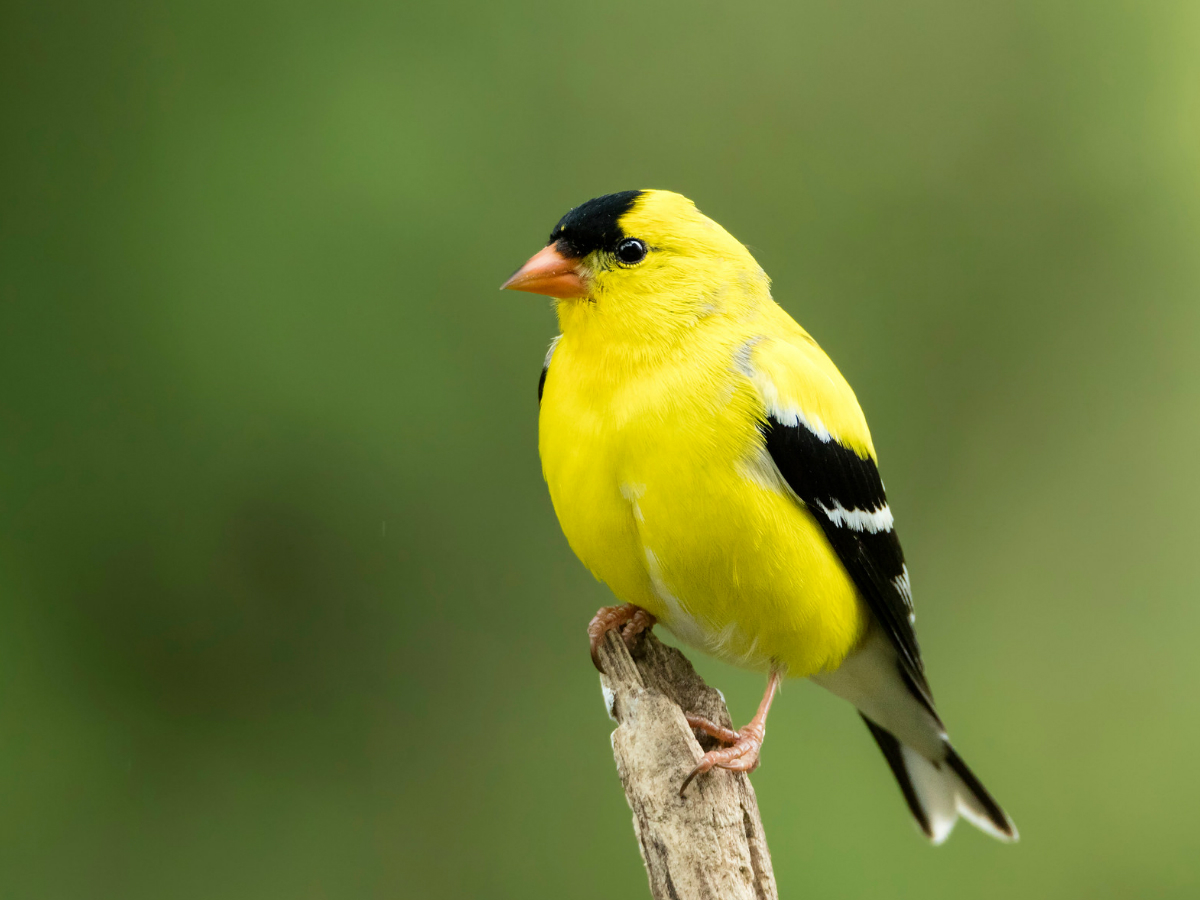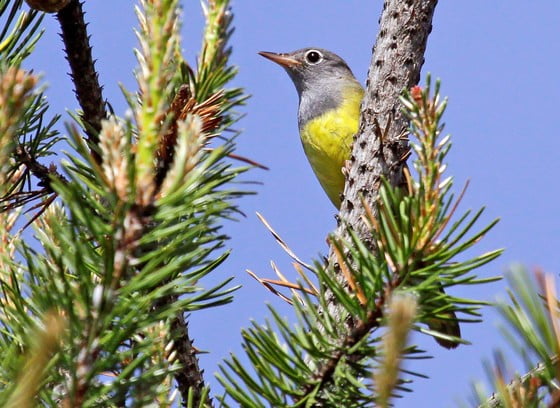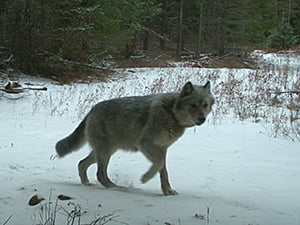Do you have a favorite bird? Can you identify some of the common birds in your area? These beautiful and fascinating animals are everywhere. It’s difficult to imagine going outside and not seeing at least one bird. With almost 1,000 species of birds in the United States, the variety of colors, crests, sizes, songs and feathers can be overwhelming. Birdwatching and identifying is a hobby that can easily become a lifelong passion for many nature lovers. It’s a pastime that draws large numbers of people to public lands across the country every year.
We’ve already featured several amazing birds before, but hope you’ll appreciate some new additions and learn some fun facts about our fine feathered friends.

Blue jay. Photo by Frank Miles, U.S. Fish and Wildlife Service.
Blue jay
Let’s start off with a bird familiar to many people. Blue jays are common in every state east of the Rockies. Their bright color, high crests and bold attitudes make them easy to recognize, but most people know them by their loud, shrill calls. Their migration patterns remain a mystery. Some migrate in flocks, others stay in one place for years. Blue jays live in forests, eating seeds, nuts and insects and are very comfortable taking a snack from your backyard bird feeder. Acorns are a favorite treat. Blue jays are known to store more than 3,000 acorns each in their winter caches and are credited with spreading oak trees after the last glacial period. If you don’t see one in your front yard, try taking a walk at Cuyahoga Valley National Park in Ohio, Piedmont National Wildlife Refuge in Georgia or Fort Niobrara National Wildlife Refuge in Nebraska.

‘I’iwi’. Photo by U.S. Fish and Wildlife Service.
‘I‘iwi’
A very rare bird, the ‘i‘iwi’ is found only in isolated parts of Hawaii. This nectar feeding member of the honeycreeper family — with its brilliant scarlet body plumage and black wings and tail — abounds in the forest canopy where ‘ōhi‘a lehua blossoms are plentiful. The ‘i‘iwi’s long, down curved, orange bill is specialized for sipping nectar from tubular flowers. The ‘i‘iwi’s “squeaky hinge” call can be heard throughout the lush forest. A unique and beautiful bird, it is being threatened by habitat destruction, invasive species and avian malaria. If you ever make it to Hakalau Forest National Wildlife Refuge, the ‘i‘iwi’s bright color makes them pretty easy to spot.

Raven. Photo by Jim Shane, Bureau of Land Management.
Common raven
Among the smartest birds, ravens can use tools, solve complicated problems and understand human behavior. They can mimic sounds and imitate human words. Always looking for the easiest solution, they work in pairs to steal food or remember locations where roadkill and trash are prevalent. Ravens seem to enjoy life, performing rolls, dives and flips while flying. If you can’t tell the difference between ravens and crows, ravens are larger and have a more pronounced beak. Found mostly in the western states, ravens thrive in forests, mountains, sagebrush, tundra, fields and cities. Watch them watching you at Mount Rainier National Park in Washington, Craters of the Moon National Monument in Idaho and Sacramento National Wildlife Refuge in California.

American goldfinch. Photo by N. Lewis, National Park Service.
American goldfinch
Adorned with feathers of bright yellow and shiny black, everything about the goldfinch is meant to show off. Its calls are loud squeaky whistles. It flies with a bouncy acrobatic style. It poses dramatically on branches and bird-feeders. Commonly found in abundant numbers across the contiguous United States, this flamboyant finch is the state bird of New Jersey, Iowa and Washington. The goldfinch is a strict vegetarian. Seeds make up the majority of its diet. Rarely hidden in the deep forests, the goldfinch prefers open fields and meadows where it can see and be seen. Look for one at Glacier National Park in Montana, Table Rock Wilderness in Oregon and Cherry Valley National Wildlife Refuge in Pennsylvania.

Northern flicker. Photo by Tom Koerner, U.S. Fish and Wildlife Service.
Northern flicker
Found year round in every state except Alaska and Hawaii, northern flickers are a type of woodpecker that hunt for insects with their sturdy beaks and long hooked tongues. They have gray-brown heads with tan and black striped backs and their chests are covered with dots that sometimes resemble little hearts. Small slashes of color differentiate the two varieties — red details in the west and yellow in the east. Northern flickers live in tree cavities and drum on objects as a form of communication and territory defense. They produce between 5 and 8 eggs in each clutch. Look and listen for them at Rocky Mountain National Park in Colorado, Aravaipa Canyon Wilderness in Arizona and Clarks River National Wildlife Refuge in Kentucky.

Loggerhead shrike. Photo by Hanna Schwalbe, National Park Service.
Loggerhead shrike (the butcher bird)
The loggerhead shrike may look like a small songbird, but the eyes of a killer stare out of its black mask. Sometimes called “the butcher bird,” the gray and white loggerhead shrike is a predator that preys on insects, birds, lizards and small mammals. Lacking talons and armed with a modest beak, this killer catches its prey and skewers it on thorns or barbed wire, leaving the carcass suspended for easy eating. Found across the Southeast, southern Great Plains and Southwest, look for them perched on fence posts, waiting for an opportunity to strike. You might see one and its unfortunate victims at Joshua Tree National Park in California, Dripping Springs Natural Area in New Mexico and Holt Collier National Wildlife Refuge in Mississippi.

Purple finch. Photo by N. Lewis, National Park Service.
Purple finch
A delight to see perched in the forest or grabbing a meal at your birdfeeder, the purple finch eats mostly seeds and sings a high, warbling tune. The females are tan and brown, but males look like they’ve been dunked in cranberry juice. To include all the colors in its life cycle, purple finch eggs are greenish-blue with black spots. A courting male will sing, hop and fluff its feathers while holding a twig or a blade of grass in its beak. Sadly, the purple finch is in decline, slowly being pushed out by the more common house finch. Its range includes much of the eastern states in the winter, but it keeps mostly to northern forests for most of the year. You’re most likely to see one at Shawangunk Grasslands National Wildlife Refuge in New York, Acadia National Park in Maine and Voyageurs National Park in Minnesota.

Common murres. Photo by Roy W. Lowe, U.S. Fish and Wildlife Service.
Common murre
No, these aren’t penguins. Common murres are abundant, gathering in large groups along the Pacific coast from California to Alaska and the Atlantic Coast north of New York. Daring hunters, they dive into the ocean and swim underwater to spear fish and pluck up squid and shrimp. This diet and exercise means murres can live more than 20 years. Nesting on rocky cliffs and rugged islands, they lay only one egg each nesting season. They have large colonies at Oregon Islands National Wildlife Refuge, Maine Coastal Islands National Wildlife Refuge and Olympic National Park in Washington.

Indigo bunting. Photo by N. Lewis, National Park Service.
Indigo bunting
Another example of a bird species in which females are plain brown and males are brightly colored, the male indigo bunting is the shade of the sky on a clear summer day. When it isn’t flying over fields looking for insects and seeds, the indigo bunting spends a lot of time perched on telephone lines singing its bouncy tune. Another fun fact about this chipper bird is that it migrates at night, navigating by the stars. In the late spring and summer, the indigo bunting spreads across the eastern U.S., but spends the winter in the Carribean and Central America. So head out to Wichita Mountains Wildlife Refuge or Cumberland Gap National Historical Park in Kentucky this July and August to see one before it flies south in the fall.

Sora. Photo by Larry Palmer, U.S. Fish and Wildlife Service.
Sora
Whether spending the summer in the northern states, migrating in the spring and fall, or wintering on the southern fringes, the sora can be found almost everywhere in the lower 48 at one time or another. Despite the fact that it gets around so much, the sora is really difficult to see. This secretive brown and gray bird stays hidden in reeds and rushes, prowling shallow wetlands on really long toes and weaving floating nests with its bright yellow bill. It is most active in the early morning or evening and reveals its presence with a rising, whining call. It is nervous around humans and other animals, but aggressive when dealing with other soras. We’re pleased to report successful sightings at Great Meadows National Wildlife Refuge in Massachusetts, Kulm Wetland Management District in North Dakota and Big Boggy National Wildlife Refuge in Texas.

Anhinga. Photo by Steve Hillebrand, U.S. Fish and Wildlife Service.
Anhinga
The anhinga is distinctive in several ways. First, its name comes from Brazillian tribes, who call this large black and silver bird “evil spirit in the woods” and “devil bird.” Perhaps that reputation comes from its habit of swimming underwater with only its head and long neck visible, like a snake patrolling the wetlands. After spearing fish with its long, sharp bill, the anhinga suns itself to dry out and then spends afternoons soaring to great heights, its large cross-shaped silhouette unmistakable from a distance. Only found near coastal wetlands, you’ll likely see one near the Atlantic and Gulf of Mexico in the South. We recommend Everglades National Park in Florida, Okefenokee National Wildlife Refuge in Georgia and Lacassine National Wildlife Refuge in Louisiana if you want to see this odd creature for yourself.

Kirtland’s warbler. Photo by Joel Trick, U.S. Fish and Wildlife Service.
Kirtland’s warbler
Though few birders are lucky enough to see this warbler in the wild, those that do catch a glimpse are sure to remember the thrill of seeing this rare species for themselves. An endangered species, the Kirtland’s warbler requires a very specific nesting habitat of large and dense jack pine forests that are only found in northern Michigan, Wisconsin and Ontario, Canada. This small, yellow and gray songbird — which prefers small trees and open areas — also requires that these forests be young, making wildfires an important part of the development of this rare habitat. For their protection, nesting sights are closed to the public, but there are guided tours. You may also catch a glimpse of one along their migration corridor in Ottawa National Wildlife Refuge in Ohio or Piedmont National Wildlife Refuge in Georgia during late April through early June when they fly north from the Bahamas where they winter. Though the Kirtland’s warbler is still classified as an endangered species today, it may not be for much longer. With a population of over 2,300 pairs, the Kirtland’s warbler has far exceeded the population goal that was set for it decades ago. That’s what we call a wildlife win!
Birdwatching is a great outdoor hobby for people across the country, but be careful, it can be addictive. Before you know it, you’ll be dreaming of colors and crests and calls, finding excuses to wander into the forest, and studying field guides to identify your new feathered friends. Explore more bird watching tips and some suggested public lands to look for them.
https://therogueoutdoorsman.com/category/nature-wildlife-news/

